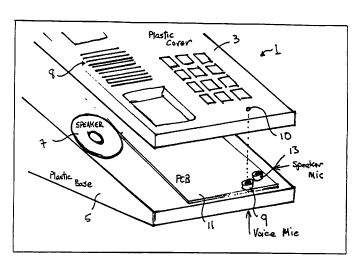Some of the information on this Web page has been provided by external sources. The Government of Canada is not responsible for the accuracy, reliability or currency of the information supplied by external sources. Users wishing to rely upon this information should consult directly with the source of the information. Content provided by external sources is not subject to official languages, privacy and accessibility requirements.
Any discrepancies in the text and image of the Claims and Abstract are due to differing posting times. Text of the Claims and Abstract are posted:
| (12) Patent: | (11) CA 2229424 |
|---|---|
| (54) English Title: | CIRCUIT TO IMPROVE TRANSDUCER SEPARATION IN HANDSFREE TELEPHONE |
| (54) French Title: | CIRCUIT VISANT A AMELIORER LA SEPARATION DU TRANSDUCTEUR D'UN TELEPHONE MAINS LIBRES |
| Status: | Deemed expired |
| (51) International Patent Classification (IPC): |
|
|---|---|
| (72) Inventors : |
|
| (73) Owners : |
|
| (71) Applicants : |
|
| (74) Agent: | SIM & MCBURNEY |
| (74) Associate agent: | |
| (45) Issued: | 2001-04-24 |
| (22) Filed Date: | 1998-02-13 |
| (41) Open to Public Inspection: | 1998-08-18 |
| Examination requested: | 1998-02-13 |
| Availability of licence: | N/A |
| (25) Language of filing: | English |
| Patent Cooperation Treaty (PCT): | No |
|---|
| (30) Application Priority Data: | ||||||
|---|---|---|---|---|---|---|
|
In a device having a sound source within an enclosure and a first microphone
for picking up sounds outside the enclosure, a system for improving acoustic
separation between the sound source and first microphone comprising an additional
microphone located approximately equidistant from the sound as the first microphone
for picking up sounds within the enclosure, and a circuit connected to the firstmicrophone and the additional microphone for subtracting the sounds within the
enclosure from the sounds outside the enclosure.
Dans un dispositif ayant une source sonore à l'intérieur d'un boîtier ainsi qu'un premier microphone destiné à capter des sons à l'extérieur du boîtier, un système permet d'améliorer la séparation acoustique entre la source sonore et le premier microphone. Ce système comprend un microphone supplémentaire situé à distance à peu près égale du son comme le premier microphone, afin de capter les sons à l'intérieur du boîtier, ainsi qu'un circuit relié au premier microphone et au microphone supplémentaire pour soustraire les sons à l'intérieur du boîtier des sons à l'extérieur du boîtier.
Note: Claims are shown in the official language in which they were submitted.
Note: Descriptions are shown in the official language in which they were submitted.

For a clearer understanding of the status of the application/patent presented on this page, the site Disclaimer , as well as the definitions for Patent , Administrative Status , Maintenance Fee and Payment History should be consulted.
| Title | Date |
|---|---|
| Forecasted Issue Date | 2001-04-24 |
| (22) Filed | 1998-02-13 |
| Examination Requested | 1998-02-13 |
| (41) Open to Public Inspection | 1998-08-18 |
| (45) Issued | 2001-04-24 |
| Deemed Expired | 2006-02-13 |
There is no abandonment history.
| Fee Type | Anniversary Year | Due Date | Amount Paid | Paid Date |
|---|---|---|---|---|
| Request for Examination | $400.00 | 1998-02-13 | ||
| Registration of a document - section 124 | $100.00 | 1998-02-13 | ||
| Application Fee | $300.00 | 1998-02-13 | ||
| Maintenance Fee - Application - New Act | 2 | 2000-02-14 | $100.00 | 2000-02-03 |
| Final Fee | $300.00 | 2001-01-23 | ||
| Maintenance Fee - Application - New Act | 3 | 2001-02-13 | $100.00 | 2001-02-02 |
| Registration of a document - section 124 | $50.00 | 2001-05-04 | ||
| Maintenance Fee - Patent - New Act | 4 | 2002-02-13 | $100.00 | 2002-01-17 |
| Maintenance Fee - Patent - New Act | 5 | 2003-02-13 | $150.00 | 2003-01-17 |
| Registration of a document - section 124 | $100.00 | 2003-02-07 | ||
| Registration of a document - section 124 | $100.00 | 2003-02-07 | ||
| Maintenance Fee - Patent - New Act | 6 | 2004-02-13 | $150.00 | 2003-12-22 |
| Registration of a document - section 124 | $100.00 | 2005-07-18 |
Note: Records showing the ownership history in alphabetical order.
| Current Owners on Record |
|---|
| MITEL NETWORKS CORPORATION |
| Past Owners on Record |
|---|
| MCLEOD, ROB |
| MITEL CORPORATION |
| ZARLINK SEMICONDUCTOR INC. |